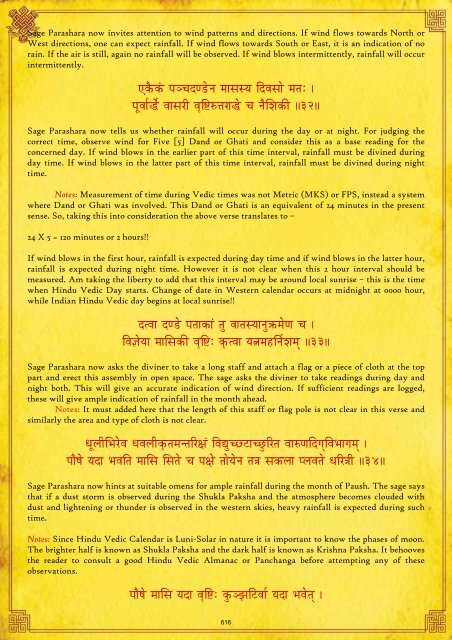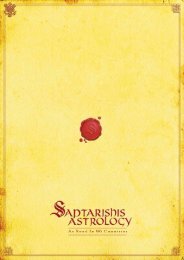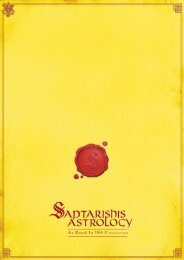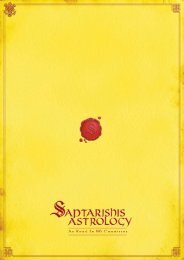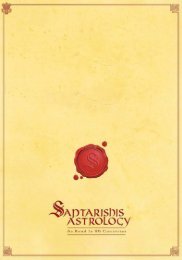SAVol7Dec09IndianCol.. - Saptarishis Astrology
SAVol7Dec09IndianCol.. - Saptarishis Astrology
SAVol7Dec09IndianCol.. - Saptarishis Astrology
- No tags were found...
You also want an ePaper? Increase the reach of your titles
YUMPU automatically turns print PDFs into web optimized ePapers that Google loves.
Sage Parashara now invites attention to wind patterns and directions. If wind flows towards North orWest directions, one can expect rainfall. If wind flows towards South or East, it is an indication of norain. If the air is still, again no rainfall will be observed. If wind blows intermittently, rainfall will occurintermittently.LMæüMÇü mÉgcÉShQåûlÉ qÉÉxÉxrÉ ÌSuÉxÉÉå qÉiÉÈ |mÉÔuÉÉï®åï uÉÉxÉUÏ uÉ×̹¨ÉUÉ®å cÉ lÉæÍzÉMüÐ ||32||Sage Parashara now tells us whether rainfall will occur during the day or at night. For judging thecorrect time, observe wind for Five [5] Dand or Ghati and consider this as a base reading for theconcerned day. If wind blows in the earlier part of this time interval, rainfall must be divined duringday time. If wind blows in the latter part of this time interval, rainfall must be divined during nighttime.Notes: Measurement of time during Vedic times was not Metric (MKS) or FPS, instead a systemwhere Dand or Ghati was involved. This Dand or Ghati is an equivalent of 24 minutes in the presentsense. So, taking this into consideration the above verse translates to –24 X 5 = 120 minutes or 2 hours!!If wind blows in the first hour, rainfall is expected during day time and if wind blows in the latter hour,rainfall is expected during night time. However it is not clear when this 2 hour interval should bemeasured. Am taking the liberty to add that this interval may be around local sunrise – this is the timewhen Hindu Vedic Day starts. Change of date in Western calendar occurs at midnight at 0000 hour,while Indian Hindu Vedic day begins at local sunrise!!SiuÉÉ ShQåû mÉiÉÉMüÉÇ iÉÑ uÉÉiÉxrÉÉlÉÑ¢üqÉåhÉ cÉ |ÌuÉ¥ÉårÉÉ qÉÉÍxÉMüÐ uÉ×Ì¹È M×üiuÉÉ rɦÉqÉWûÌlÉïzÉqÉç ||33||Sage Parashara now asks the diviner to take a long staff and attach a flag or a piece of cloth at the toppart and erect this assembly in open space. The sage asks the diviner to take readings during day andnight both. This will give an accurate indication of wind direction. If sufficient readings are logged,these will give ample indication of rainfall in the month ahead.Notes: It must added here that the length of this staff or flag pole is not clear in this verse andsimilarly the area and type of cloth is not clear.kÉÔsÉÏÍpÉUåuÉ kÉuÉsÉÏM×üiÉqÉliÉËU¤ÉÇ ÌuɱÑcdOûÉcNÒûËUiÉ uÉÉÂhÉÌSaÉçÌuÉpÉÉaÉqÉç |mÉÉæwÉå rÉSÉ pÉuÉÌiÉ qÉÉÍxÉ ÍxÉiÉå cÉ mɤÉå iÉÉårÉålÉ iÉ§É xÉMüsÉÉ msÉuÉiÉå kÉËU§ÉÏ ||34||Sage Parashara now hints at suitable omens for ample rainfall during the month of Paush. The sage saysthat if a dust storm is observed during the Shukla Paksha and the atmosphere becomes clouded withdust and lightening or thunder is observed in the western skies, heavy rainfall is expected during suchtime.Notes: Since Hindu Vedic Calendar is Luni-Solar in nature it is important to know the phases of moon.The brighter half is known as Shukla Paksha and the dark half is known as Krishna Paksha. It behoovesthe reader to consult a good Hindu Vedic Almanac or Panchanga before attempting any of theseobservations.mÉÉæwÉå qÉÉÍxÉ rÉSÉ uÉ×Ì¹È MÑügfÉÌOûuÉÉï rÉSÉ pÉuÉåiÉç |616


